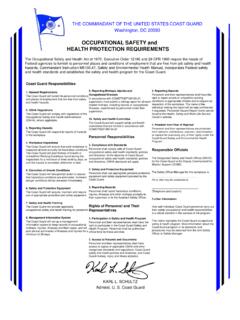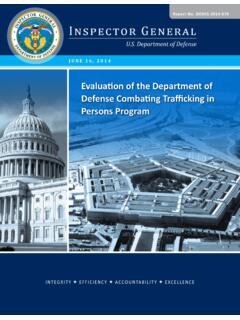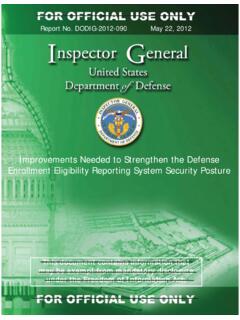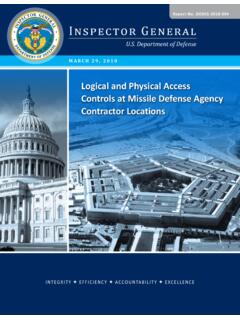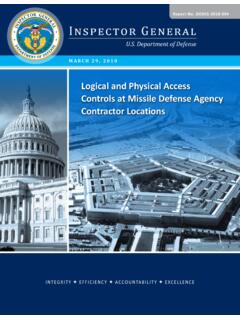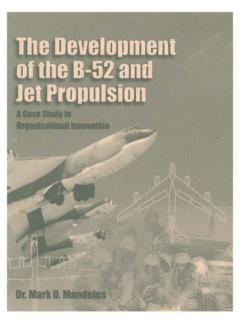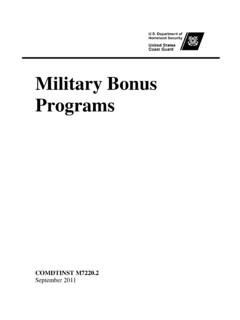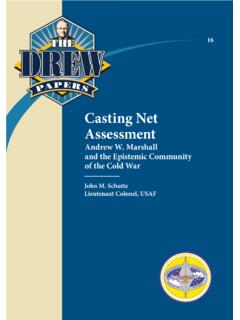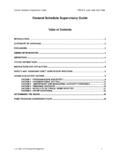Transcription of Report on Countering Extremist Activity Within the ...
1 Report on Countering Extremist Activity Within the Department of Defense December 2021 2 The overwhelming majority of the men and women of the Department of Defense serve this country with honor and integrity. They respect the oath they took to support and defend the Constitution of the United States. We are grateful for that We owe the men and women of the Department of Defense an environment free of Extremist activities, and we owe our country a military that reflects the founding values of our democracy. Secretary of Defense Lloyd J. Austin III Memorandum, December 20, 2021 3 executive SUMMARY This Report outlines ongoing work by the Department of Defense to address the threat posed by prohibited Extremist activities.
2 The Department of Defense has long prohibited Service members from actively engaging in Extremist activities. Since 1969, the Department of Defense has provided policy guidance that enumerates the prohibition of specific activities, and has routinely updated its guidance to clarify prohibited activities, clarify the investigative authorities that commanders have at their disposal, and ensure that all military departments implement training on these policies. Following a number of high-profile insider threat attacks in the early 2010s, the Department of Defense built a program to detect, deter, and mitigate such threats to the Department, its people, and its mission.
3 In 2019, Congress directed the Department of Defense to review existing policies and capabilities with the aim of closing gaps in personnel security vetting. In 2020, the Army published a comprehensive revision of Army Command Policy (AR 600-20) which was the first of its kind to address the use of social media to support Extremist activities and provided guidance to commanders for addressing prohibited Activity that crosses the line into misconduct. In February 2021, Secretary of Defense Lloyd J. Austin III directed a Department-wide stand down to educate Department of Defense personnel on the threat posed by Extremist Activity .
4 In April 2021, following the stand down, Secretary Austin issued a second memorandum to implement immediate actions identified by subject-matter experts Within the Department of Defense (and informed by the stand down), and directed the establishment of the Countering Extremist Activity Working Group (CEAWG) to implement these urgent steps and develop additional recommendations. This Report provides background on the work completed by the Department. It also details the implementation status of the Secretary s four directed actions from April and describes the six additional recommendations and associated actions developed by the CEAWG.
5 With the publication of this Report , the Secretary of Defense has directed the implementation of the six CEAWG recommendations and associated actions. The immediate actions were: Review and update DoD Instruction , Handling Protest, Extremist , and Criminal Gang Activities Among Members of the Armed Forces, to clarify the definition of prohibited Extremist Activity Update the Service member transition checklist Review and standardize screening questionnaires Commission a study on Extremist Activity in the Total Force. 4 The six additional CEAWG recommendations fall Within the following lines of effort: Military Justice and Policy, Support and Oversight of the Insider Threat Program, Investigative Processes and Screening Capability, and Education and Training.
6 Key recommendations include: Developing a comprehensive training and education plan that provides regular training on prohibited Extremist Activity to Department of Defense personnel , including those advancing to leadership positions. Reviewing and updating policies to provide notice to the Total Force and Department of Defense contractor personnel on prohibited Extremist Activity . Improving and modernizing Insider Threat programs by enhancing capabilities, maximizing information sharing, and ensuring a consistent and full understanding of any legal requirements. 5 1. INTRODUCTION At the direction of Secretary of Defense Lloyd J.
7 Austin III, the Department of Defense (DoD) is addressing the threat posed by prohibited Extremist activities, and taking steps to ensure that Service members, DoD civilian employees, and all who support the Department s mission can serve in a secure environment free from discrimination, hatred, and harassment. Countering Domestic Terrorism In 2020, both the Federal Bureau of Investigation and the Department of Homeland Security found that a range of Extremist motivations and behaviors constituted a growing threat to the United States. On June 15, 2021, the Biden Administration released the first-ever National Strategy for Countering Domestic Terrorism to address the security challenge posed by domestic terrorism.
8 The Report followed a 100-day comprehensive review of efforts to address domestic terrorism. Upon its release, the White House noted in a fact sheet: Domestic terrorism is not a new threat in the United States, yet it is a threat Americans have endured too often in recent years. The comprehensive strategy provides a nationwide framework for the Government and partners to understand and share domestic terrorism related information; prevent domestic terrorism recruitment and mobilization to violence; disrupt and deter domestic terrorism Activity ; and confront long term contributors to domestic terrorism.
9 Our approach will protect both the nation and the civil liberties of its citizens. The Department of Defense s policies and programs related to Countering Extremist Activity correlate with the National Strategy. The efforts of the Department of Defense s CEAWG primarily fall Within National Strategy Pillars Three (Disrupt and Deter Domestic Terrorism Activity ) and Four (Confront Long-Term Contributors to Domestic Terrorism). Background on the Prohibition of Extremist Activity in the Armed Forces Since 1969, the Department of Defense has provided policy guidance that enumerates the prohibition of specific activities by members of the Armed Forces.
10 Over the subsequent five decades, that guidance has been routinely updated in response to significant events. In 1986, in response to the White Patriot Party's weapons theft incident, the guidance was updated with an addition of "prohibited activities." Later in the mid-1990s, following a series of high profile incidents, additional points were added to clarify the investigative authorities that commanders had at their disposal while also ensuring that all military departments implemented training on these policies. Following a number of serious insider threat attacks in the early 2010s, the Department built a program to detect, deter, and mitigate such threats to the Department, its people, and its mission.
